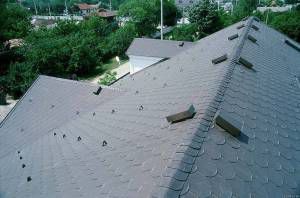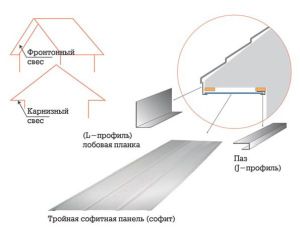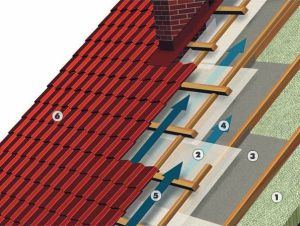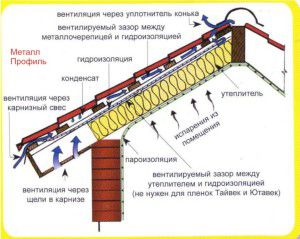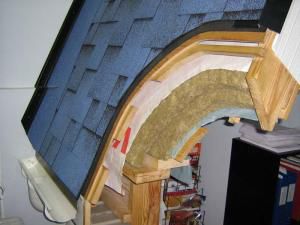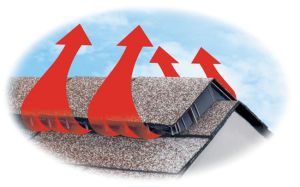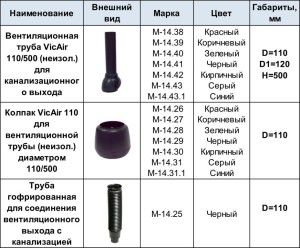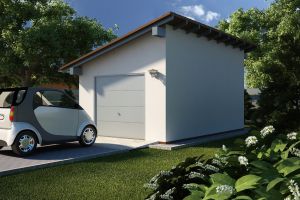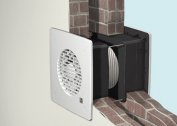Ventilation of the roof of the house is necessary, as well as ventilation of the attic or bathroom. On the surface of an unventilated roof, the temperature and humidity regime is violated. Drops of condensate settle on the roofing material and supporting structures, causing rotting, destruction and leading to frequent repairs.
Why roof ventilation is needed
Due to the temperature difference, condensation collects in the under-roof space. Water enters the insulation, its insulating qualities deteriorate. The more moisture under the roof, the worse it keeps the temperature.
Most often, the rafter system is assembled from a tree, subject to rotting with constant contact with moisture. The rafters covered with mold are destroyed, threatening collapse.
The accumulation of water in a roofing carpet made of soft materials causes peeling of the coating. The roof starts to flow. And only roof ventilation will help prevent all troubles.
Pros of houses with ventilated roofs:
- the roof space is blown with fresh street air;
- keeps the optimum temperature and humidity in the attic;
- the properties of the insulating material are preserved;
- roofing materials and supporting structures are protected from mold, fungus, sagging.
Poor roof ventilation in a private house causes:
- wet rafter structure, rotting, deterioration of bearing properties;
- deformation or rusting of the roofing material;
- destruction of stone and concrete parts;
- a decrease in the thermal insulation qualities of the roof, which means an increase in the cost of heating the house;
- overheating of the house and the roof in the hot season.
In this regard, it is worth mentioning the importance of ventilation of the attic roof, where the under-roof space is residential.
Roof ventilation methods
The roof ventilation of any private house is carried out by the method of natural air movement in the under-roof space.
There are several mechanisms for providing roof ventilation in a private house:
- ventilation of the ridge of the gable roof.
- cornice ventilation.
- exhaust roof fans.
- piece elements with air vents.
- special design skates.
- ventilation gaps, which provide for the installation of the roof.
- dormer windows in the attic.
And now we will consider the features of different designs of ventilation of roofs of houses, assembled from different materials.
Flexible roof ventilation
When laying flexible tiles, a clearance is left for ventilation. But for the free movement of air on both sides of the roof, it is necessary to observe several more conditions.
Flexible roof tile ventilation requirements:
- A bar of 50 mm is inserted between the insulation and the base of the roof;
- Ventilation slots are left at the bottom of the roof slope, through which fresh air enters. This is a favorite place for small bird settlements. Therefore, it is desirable to cover the slots for ventilating the roof from the soft roof with a grill or soffits;
- Air exhaust is provided by ridge vents or aerators;
- The crate is installed in a special way, with gaps, so that air flows freely pass from bottom to top;
- The height of the air gap is determined by the thickness of the beam. Which is chosen depending on the length of the ramp and the angle of the roof. Only an expert can correctly calculate the width of the air gap.
For example, when the length of the ramp is 5 meters, the angle of 10 degrees is enough 5 cm, if the angle is the same, and the length of the ramp is 25 meters, you need a beam 10 cm thick.
The ventilation of the roof from the soft roof can be done 1 or 2-circuit. The dual-circuit system is considered in the attached illustration.
Here:
1 - insulation2 - vapor barrier,3 - anti-hurricane protection,4 - the first slot for ventilation,5 - a second ventilation slot,6 - roofing.
Forced flexible roof ventilation
To increase the ventilation efficiency of the roof from flexible tiles, aerators are installed. The aerator always has reduced pressure, so the thrust never disappears.
Aerators are available in various diameters and heights. The size and quantity are selected depending on the area of the roof from flexible tiles.
Aerator ventilation is equipped according to the rules:
- between two aerators should be at least 12 meters;
- they are installed on the highest places of the roof, evenly;
- if the roof has recently been installed, it is preferable to choose the joints of the insulation;
- if aerators are installed during repair of a roof from a soft roof, the best place for a ventilation element is where the roof is slightly swollen;
- the diameter of the hole for the flygark should be 1 - 2 cm larger than the diameter of the pipe itself;
- the aerator is attached with anchor bolts or dowels;
- the joint must be sealed or glued with a special tape.
Roof ventilation
Ventilation of the roof over the attic has an additional important function of regulating the temperature inside the residential attic. The bottom surface of the roofing cake is actually adjacent to its ceiling. Thus, the movement of air along the inner plane provides additional thermal insulation. Therefore, a special technology has been created for the construction of attic roof ventilation with the outlet of moist, hot or cold air to the outside.
The principles of natural ventilation are used: warm air is forced out by a cold stream going from below.
Attic roof ventilation components:
- vapor barrier film or membrane (selected with minimal permeability);
- insulation, which is placed between the rafters;
- crate;
- counter-lattice made of battens or bars;
- waterproofing;
- roofing.
The diffusion membrane completely prevents condensation. A special membrane fabric does not allow moisture from below (from the living space of the attic) to the lower surface of the roof. However, under the roofing material there is a gap for the unhindered movement of air masses. Waterproofing prevents the penetration of moisture from the outside.
It is also necessary to provide slots in the cornice for air inlet and in the area of the ridge for exit. The upper ventilation gap is located between the waterproofing and the roofing. Water entering from the street evaporates through this outlet. The structures supporting the roof are also well ventilated.
The lower ventilation gap is located between the waterproofing and the insulation layer. Water evaporates through it, penetrating into the insulation from below. The air from the living room is saturated with water vapor that must be removed.
Steam and roof waterproofing
Insulating films are laid on the rafters, between which there are spaces of no more than 120 cm. To prevent condensation from falling onto the wooden beams, the film is mounted with a sag of 1 - 2 cm. Fix it with a stapler or nails with a wide galvanized hat. If the hat is not large enough, the film will break. Cloths are laid out with an overlap of 15 cm, which is glued with tape.
A gap of at least 4 cm should remain between the insulation layer and the waterproofing. The film is rolled along the rafters and fastened with rails along them, nailing with galvanized nails.
The counter grill consists of bars that are installed at intervals of 15 cm.
In the area of the ridge, it is necessary to leave 5 cm between the edge of the insulation and the axis of the ridge for breathing. And only now you can build a crate, the type of which depends on the material of the roof.
It is important to properly handle the places where pipes enter the roofing cake. The film is notched in the form of a truncated triangle. It looks like valves that are mounted on the walls of the pipe or bars with tape-sealant.
A vapor barrier is mounted with a vapor barrier; no lower gap is left. But the upper air between the membrane and the crate is necessary.
To protect the roofing material from the effects of steam from residential premises, use fleecy membranes attached to the insulation with a smooth surface inside. On small hairs, droplets of water are held without sliding into puddles. Such a vapor barrier extends the life of the insulation and wooden structures, and maintains the quality of insulation. Thanks to the film, mildew colonies do not form on the rafters.
The vapor barrier strips are rolled across the insulating material, 15 cm overlap, the edges are glued with special tape.
Skate aerator for ventilation
The ridge aerator provides ventilation for the roof ridge and helps maintain the temperature and humidity in the attic. Ready-made ridge aerators can be mounted on any type of roof.
They are installed only on roofs with a slope of 14 to 45 degrees. On the roof, skate products are necessarily equipped. The length of the aerator must match the length of the ridge. From the chimney to the ridge cut, a distance of 30 cm or more is maintained. The design of the ventilated roof ridge must be airtight.
Roof vents
Deflectors or roof aerators are mechanisms for removing moisture and steam from a roof cake. The aerator uses the convection method.
The deflector in the attic roof provides:
- steam evacuation before it reaches the roofing materials;
- pressure reduction, preventing the appearance of swelling of mineral wool, used as a heater;
- evacuation of moisture from mineral wool, preventing condensation.
According to the standards for attic roof ventilation, it is necessary to equip 1 deflector for every 100 square meters. meters. This density allows you to effectively remove excess moisture. If the roof valley is very steep and the skates are tilted, the deflectors are placed in the valley and along the ridge run on the joints of the insulation layer.
Roof ventilation made of metal
The ventilation of the roof of the house made of metal has some features.
Continuous ventilation is provided during the installation of the roofing cake and lies in the fact that between the roofing material and the thermal insulation there is a gap of up to 5 cm. The bottom layer of insulation is ventilated thanks to a 5 cm gap to the crate. And so that the wood does not get wet, a sealant is placed under the ridge.
The area of ventilation slots at the eaves should be equal to the area of the ridge vents (the inflow volume is equal to the outflow volume). The total area of vents should be 1% of the roof area. If during the design and construction of the house the ventilation of the roof made of metal is not thought out, there is an express method for ready-made roofs.
The basis of roof ventilation in this case are ventilation pipes and ventilation outlets. The height of the pipe should be 50 cm or more. For every 60 square meters. meters of roof area is installed 1 pipe as close to the ridge as possible. By the time of installation of the ventilation point outputs, the video of which we present, the roof of the metal tile must be fully assembled.
Most often they use plastic pipes, they do not violate the appearance of the building and serve for a long time.
In areas with heavy snowfall in winter, pipes up to 65 cm long are installed.The places where the pipes adjoin the roof are hermetically sealed. When the roof is flat, and the slopes are more than 6 m long, ventilation adjoins are equipped. The height of the junctions is from 40 cm above the roof. Instead of a regular pipe, it is sometimes more efficient to use the deflectors shown in the video of the roof ventilation made of metal.
The ventilation of the roof ridge under the metal tile is provided by the ridge board separating the two roof slopes. On the one hand, air exits unhindered, preventing the formation of condensate.
Natural ventilation is used to ventilate the roof space. And it will work only if the number and location of ventilation outlets is accurately calculated.
Mounting the ventilation outlet
The point exits are suitable for ventilation of a hip and pitched roof of a small area. Complex roofs with several skates are equipped with an exit for each skate. The distance to the ridge should not be more than 0.6 m. It is not advisable to mount two exits on one sheet of metal, so as not to weaken the structure.
When purchasing a ventilation outlet for a roof made of metal, the following parameters are taken into account:
- the profile of the lining must coincide with the profile of the metal tile;
- pipe color;
- temperature limits for this instance;
- the kit should include installation instructions, overlays, a template, fasteners, the pipe itself, as well as a passage element;
- the diameter of the pipe depends on the area of the roof.
The most important point in the installation of point ventilation of a roof made of metal is the teething of the hole of the right size and the tight installation of the pipe. If the device is assembled correctly, in accordance with the annotation, then the junction with the roof will be insulated from rain or snow.
The hole is cut out clearly according to the attached template using metal scissors or a hacksaw, but not the grinder that spoils the coating.
Tightness is ensured by silicone, which is treated with a sealing circle. Next, the passage element is attached with screws from the kit and a pipe is inserted into it. The passage element is necessary for fixing the pipe. To make the fastening reliable, the hole in it is cut a quarter less than the diameter of the pipe. Sometimes this unit is sold already assembled. The pipe should be installed vertically, which is checked by the level. Now it is fixed with screws and covered with decorative overlays.
Roof ventilation from corrugated board
Roof ventilation from corrugated board is organized by a natural method similar to the metal roof ventilation shown in the video. In the area of the eaves overhang, air penetrates into the subfloor space, freely passes up to the ridge and is discharged by the tented ridge. If the skate is no longer than 10 m, through the end.
The ventilation of the subsurface roof space from corrugated board is provided by installing ventilation slats on the waterproofing layer. The lowest rail near the cornice should be 50% thicker than the others.
The waterproofing does not reach the ridge of the roof, so that, providing high-quality ventilation of the roof from the corrugated board, not to impede the release of fumes. And the flow of water from the outside is prevented by the compaction of the ridge by the “top roll” system. You can also install the ventilation ridge of the roof under the corrugated board or metal.
Shed roof ventilation
More often, gable roofs are installed over verandas and terraces where ventilation is not needed. And a completely different situation when it is above a residential building. The ventilation of a shed roof is very simple and this is a great design advantage. There is no need to purchase aerators or mount a special-shaped ridge, but only correctly assemble the roof itself.
A pitched roof certainly needs ventilation. Under the roofing material there is room for the free movement of air flows. The movement is from bottom to top.Therefore, a gap is left between the thermal insulation layer and the waterproofing. Often, additional ventilation holes are drilled in the cranked walls.
Roof overhangs are sewn up with perforated soffits. When installing the battens between the boards, small gaps are left. You can also install ventilation grilles. Shed roofs are ventilated with a slope of 5 to 20 degrees.
Hip roof ventilation
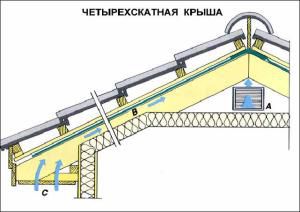 During the construction of hip roof ventilation, they are guided by the principles already stated above. This is a natural ventilation method in which air enters the under-roof space from under the eaves and exits near the ridge.
During the construction of hip roof ventilation, they are guided by the principles already stated above. This is a natural ventilation method in which air enters the under-roof space from under the eaves and exits near the ridge.
Therefore, special attention should be paid to the wind filing of cornices. If the cornice is hemmed with wood, gaps are left between the boards. It is more convenient to make a binder from a ready-made perforated plastic (spotlights). If the binder is ready and ventilation is not provided, openings are cut out into which grilles for the ventilation of the hip roof are mounted. The diameter of the gratings is 5 cm, they are covered with a fine mesh. Between the grates are left spaces of not more than 0.8 meters. On sale there are models of various colors and shapes.
